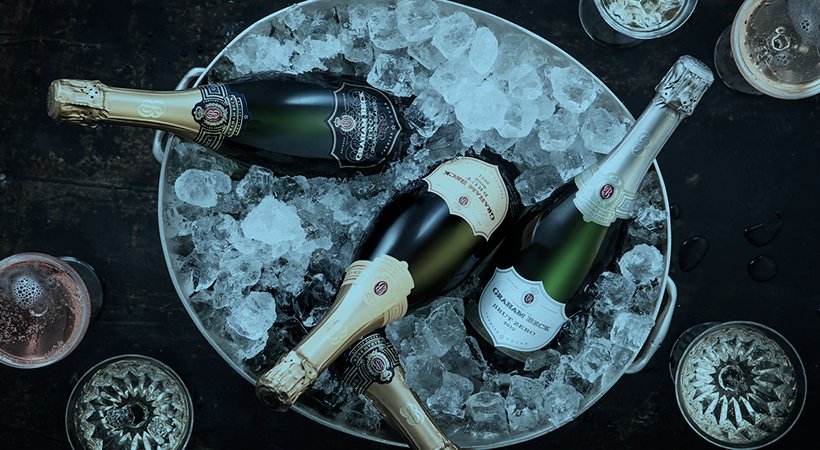Stay abreast of COVID-19 information and developments here
Provided by the South African National Department of Health
How well do you
know your bubbles?
Ahead of the Franschhoek Cap Classique & Champagne Festival in December* – and with summer the season for popping the cork on your favourite bubbly – we asked the experts to unpack a few interesting facts about fizz.
French champagne has long been considered the gold standard for sparkling wines, and it’s sold at a considerable premium in South Africa. But is it worth the spend?
‘Champagne has a taste and quality like no other!’ enthuses Roland Peens, Director of winecellar.co.za and one of South Africa’s leading wine judges. ‘This sparkling wine – which comes from the Champagne region of France – is arguably the most successful beverage in the world. Around 300 million bottles are produced annually, at an average price that far exceeds that of any other wine region. Champagne combines prestige, quality and celebration.’
While South Africa remains a small market for traditional dry champagnes, it’s a large and growing market for off-dry versions, dominated by Moët & Chandon and Veuve Clicquot, Peens adds. Grand Marque houses, including Krug and Dom Pérignon, remain popular, with good demand among local wine lovers for the smaller houses of Drappier and Jacquesson.
Beyond France? Look to our local Méthode Cap Classique (MCC), says Peens. ‘Our style is very similar to that of the Champagne region and the quality is improving. There are excellent versions from other countries, but they’re not widely available in South Africa, and frankly wouldn’t offer anywhere near the value of good MCC.’
Across the globe, premium sparkling wines are dominated by two cultivars: chardonnay and pinot noir. That’s largely down to the strict rules governing champagne production, which is restricted to these two cultivars, along with the less well known pinot meunier.
Rules aside, that cultivar combination is a classic for good reason, says Jacques Wentzel, winemaker at Black Elephant Vintners in Franschhoek. ‘Chardonnay brings that fruit freshness, minerality and acidity, while pinot noir adds another layer of complexity. It brings riper fruit, structure and ageability to the wine.’
If you’re looking to expand your palate, a handful of local producers are dabbling with other cultivars to create elegant bubblies. At Delaire Graff outside Stellenbosch, winemaker Morné Very produces a superb sparkling wine made from chenin blanc, a style typical of the Loire region of France, while in the brave new winemaking world of Prieska, Lowerland is turning heads with its MCC from colombard.
Despite their effervescence conjuring up a sense of instant celebration, the craftsmanship and complexity inherent in premium MCC and champagne require a generous investment of time. And both have a trick up their sleeve – they’re aged twice.
The first ‘ageing’ takes places during the secondary fermentation in the winery, when the addition of yeast creates natural carbonation inside the bottle. Once these yeast cells have died, they settle in the bottle to form sediment known as lees.
‘Time on the lees is crucial to develop secondary aromas. This brings the necessary yeasty aromas to the MCC,’ says Pieter ‘Bubbles’ Ferreira, long-time Cellar Master at acclaimed producer Graham Beck. Extended time on the lees also creates a finer ‘mousse’ and more elegant bubbles.
To be labelled as MCC, local regulations dictate that the wine must spend a minimum of nine months on the lees, although some producers age theirs for much longer. The limited-release Lourensford Cuvée 89 MCC Brut Zero 2007 was aged for an exceptional 89 months before disgorgement.
After disgorgement – where the cork is inserted and the muselet wire fitted – additional ageing on the cork ‘brings complexity and texture’, says Ferreira. ‘[If] you like youthfulness and freshness you’ll drink MCC young, and if you like texture and complexity you’ll drink it after some cork maturation – in three to five years.’

It’s not uncommon to hear the phrase ‘vintage champagne’ bandied about. But isn’t all wine from a vintage simply from grapes picked in a particular year of harvest?
In Champagne, a ‘vintage’ is only declared in exceptional years, and the champagnes of that year will be made only from grapes of that particular harvest. By contrast, in ‘non-vintage’ years, the wine in the bottle is blended from a range of harvests.
‘Champagne is a very marginal climate and subject to very bad weather in some years, which can severely affect the harvest,’ explains Cathy Marston, a wine educator accredited with the internationally respected Wine & Spirit Education Trust (WSET).
‘Because champagne houses want to be able to sell some wine every year, it makes sense to blend it and make it more consistent. So if you do have a bad vintage, it’ll be blended with wine from previous, better vintages to make the house style.’
This means that even in vintage years, some wine is held back for the lean times in the future. The result? Less vintage champagne for sale, and a price heading north.
Another thorn in champagne’s side is the seemingly inexorable growth of prosecco, the sparkling wine made only in the Veneto region of Italy. Unlike MCC or champagne, it’s produced in the ‘charmat’ method, using pressurized steel tanks for fermentation instead of barrels and bottles.
The upshot? A sparkling wine that goes from vine to glass in months, not years, to capture vibrant fruity notes of honey, pear and apple. Don’t put prosecco away for a special occasion: it has a short shelf life – two to three years – and is best drunk young.
The choice of stemware when pouring sparkling wine is almost as tricky as choosing the wine itself.
The wide champagne coupes that were once en vogue have long been replaced by the ubiquitous champagne flute. The bad news is, while those flutes may show off the delicate stream of bubbles, they’re not doing the flavours any favours. Even Maximilian Riedel, scion of family-owned glassmaker Riedel, has said his goal is to make champagne flutes obsolete.
Instead, the trend is towards a tulip-shaped glass, rather like an elongated white wine glass. The bulbous mid-section shows off the fine bead of bubbles, while the narrowing top traps the aromas of the wine as the bubbles break the surface.
* The Franschhoek Cap Classique & Champagne Festival – sponsored by Sanlam Private Wealth – takes place on 1 and 2 December 2018. For details, visit www.franschhoekmcc.co.za
We provide daily reporting of trades, monthly portfolio evaluations and annual tax reports to clients.
Riaan Gerber has spent 16 years in Investment Management.

Have a question for Riaan?
South Africa
South Africa Home Sanlam Investments Sanlam Private Wealth Glacier by Sanlam Sanlam BlueStarRest of Africa
Sanlam Namibia Sanlam Mozambique Sanlam Tanzania Sanlam Uganda Sanlam Swaziland Sanlam Kenya Sanlam Zambia Sanlam Private Wealth MauritiusGlobal
Global Investment SolutionsCopyright 2019 | All Rights Reserved by Sanlam Private Wealth | Terms of Use | Privacy Policy | Financial Advisory and Intermediary Services Act (FAIS) | Principles and Practices of Financial Management (PPFM). | Promotion of Access to Information Act (PAIA) | Conflicts of Interest Policy | Privacy Statement
Sanlam Private Wealth (Pty) Ltd, registration number 2000/023234/07, is a licensed Financial Services Provider (FSP 37473), a registered Credit Provider (NCRCP1867) and a member of the Johannesburg Stock Exchange (‘SPW’).
MANDATORY DISCLOSURE
All reasonable steps have been taken to ensure that the information on this website is accurate. The information does not constitute financial advice as contemplated in terms of FAIS. Professional financial advice should always be sought before making an investment decision.
INVESTMENT PORTFOLIOS
Participation in Sanlam Private Wealth Portfolios is a medium to long-term investment. The value of portfolios is subject to fluctuation and past performance is not a guide to future performance. Calculations are based on a lump sum investment with gross income reinvested on the ex-dividend date. The net of fee calculation assumes a 1.15% annual management charge and total trading costs of 1% (both inclusive of VAT) on the actual portfolio turnover. Actual investment performance will differ based on the fees applicable, the actual investment date and the date of reinvestment of income. A schedule of fees and maximum commissions is available upon request.
COLLECTIVE INVESTMENT SCHEMES
The Sanlam Group is a full member of the Association for Savings and Investment SA. Collective investment schemes are generally medium to long-term investments. Past performance is not a guide to future performance, and the value of investments / units / unit trusts may go down as well as up. A schedule of fees and charges and maximum commissions is available on request from the manager, Sanlam Collective Investments (RF) Pty Ltd, a registered and approved manager in collective investment schemes in securities (‘Manager’).
Collective investments are traded at ruling prices and can engage in borrowing and scrip lending. The manager does not provide any guarantee either with respect to the capital or the return of a portfolio. Collective investments are calculated on a net asset value basis, which is the total market value of all assets in a portfolio including any income accruals and less any deductible expenses such as audit fees, brokerage and service fees. Actual investment performance of a portfolio and an investor will differ depending on the initial fees applicable, the actual investment date, date of reinvestment of income and dividend withholding tax. Forward pricing is used.
The performance of portfolios depend on the underlying assets and variable market factors. Performance is based on NAV to NAV calculations with income reinvestments done on the ex-dividend date. Portfolios may invest in other unit trusts which levy their own fees and may result is a higher fee structure for Sanlam Private Wealth’s portfolios.
All portfolio options presented are approved collective investment schemes in terms of Collective Investment Schemes Control Act, No. 45 of 2002. Funds may from time to time invest in foreign countries and may have risks regarding liquidity, the repatriation of funds, political and macroeconomic situations, foreign exchange, tax, settlement, and the availability of information. The manager may close any portfolio to new investors in order to ensure efficient management according to applicable mandates.
The management of portfolios may be outsourced to financial services providers authorised in terms of FAIS.
TREATING CUSTOMERS FAIRLY (TCF)
As a business, Sanlam Private Wealth is committed to the principles of TCF, practicing a specific business philosophy that is based on client-centricity and treating customers fairly. Clients can be confident that TCF is central to what Sanlam Private Wealth does and can be reassured that Sanlam Private Wealth has a holistic wealth management product offering that is tailored to clients’ needs, and service that is of a professional standard.